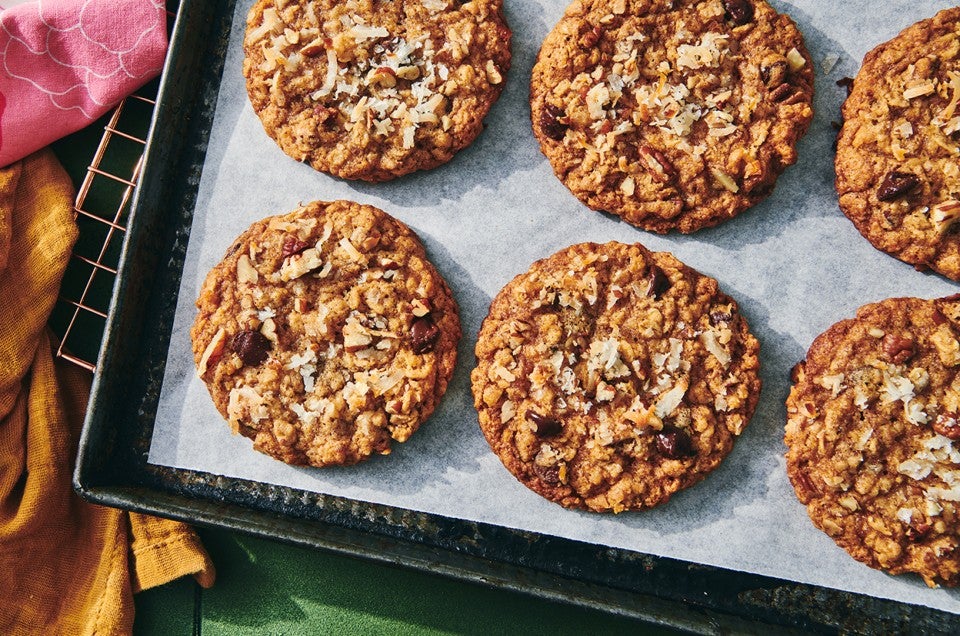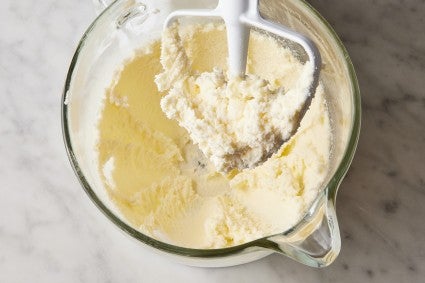


 The bakers of King Arthur are here to solve the kitchen conundrums you share with us, whether on the phone, computer, or by the good old postal service. In Ask the Baker’s Hotline, Annabelle picks the brains of the talented King Arthur Baker’s Hotline to tackle your most-asked questions. Today’s query: Why are my cookies flat?
The bakers of King Arthur are here to solve the kitchen conundrums you share with us, whether on the phone, computer, or by the good old postal service. In Ask the Baker’s Hotline, Annabelle picks the brains of the talented King Arthur Baker’s Hotline to tackle your most-asked questions. Today’s query: Why are my cookies flat?
* * *
If you’re trying to bake a batch of thick, chewy cookies, the last thing you want is to pull out a tray of thin, crispy ones. Xander over on our Baker’s Hotline is here to explain why cookies sometimes come out flat, how to ensure it doesn't happen to your next batch, and how to use flat cookies if you end up with a less-than-ideal batch.
Flat cookies can happen for various reasons, but the good news is that most of these issues can be fixed with a few easy adjustments.

“The number one reason cookies turn out flat is over-creaming the butter and sugar,” Xander says. The creaming process is a key step in many cookie recipes to incorporate air, which is crucial for the cookie’s structure. “If over-creamed, the butter can come out of emulsion (the fat and water in the butter separate), and the fat leaks out while baking, leading to flat, greasy cookies.” To avoid this, cream the butter and sugar just until they are light and fluffy, about 2 to 3 minutes. See this blog for step-by-step visuals.
Because flour provides integral structure to the dough, “not using enough flour causes cookies to spread too much,” explains Xander. Measure your flour with a scale for consistent accuracy, as seen here. In the same vein, too much sugar leads to the same flat results. “Sugar melts while baking, becoming a liquid ingredient and causing the dough to spread,” Xander shares. If your cookies are consistently coming out flat, weigh your sugar to ensure you're using the right amount. And if your cookies are still flat, try reducing the sugar in your recipe by a tablespoon or two.
Chilling the dough before baking is crucial for preventing flat cookies. “When the dough is chilled, the butter takes longer to melt, allowing the cookie to set properly,” Xander says. For best results, chill the dough for at least 30 minutes to an hour, or overnight if possible — don’t skip this step if your recipe calls for it! Our Recipe of the Year, Supersized, Super-Soft Chocolate Chip Cookies, uses an overnight rest to prevent flat cookies (and, as a bonus, ensure deeper flavor too).

We tested cookies on a variety of baking surfaces to determine which method resulted in the best cookies and found that a foil-lined baking sheet led to thin, flat cookies. Instead, use a baking sheet lined with (un-greased) parchment paper or a silicone cookie mat for thick, chewy cookies.
If your oven is too cool while baking, the cookies can spread too much before they’ve set and wind up flat. Always use an oven thermometer to make sure you’re baking at the correct temperature.
If your cookies still turn out flat despite your best efforts, try adding 1/2 tablespoon of Instant ClearJel to the dough. Instant ClearJel is a thickening agent that absorbs excess moisture, giving the dough a stable structure and helping cookies bake up thicker. For this and many other reasons, it’s a must-have pantry staple.

“Even if your cookies turn out flatter than you'd like, there are plenty of ways to repurpose them,” Xander shares.
If this post made you especially hungry for cookies, start with Supersized, Super-Soft Chocolate Chip Cookies. It took 1,200 cookies to perfect the recipe — you won’t regret it!
Cover photo (Cowboy Cookies) and food styling by Liz Neily.


December 11, 2024 at 2:57pm
What parchment papers are ungreased? When I type it in, it just keeps coming up unbleached parchment, not ungreased
January 8, 2025 at 12:07pm
In reply to What parchment papers are… by Maureen Johnston (not verified)
Hi Maureen, our parchment papers have a light silicone coating but are not greased. Hope this helps!
February 2, 2025 at 11:27am
In reply to What parchment papers are… by Maureen Johnston (not verified)
It just means to not grease the parchment paper with oil/butter/spray before using.
October 29, 2024 at 1:34am
I recently moved to Colorado at about 5,000 feet above sea level. Will the Instant Cleargel trick work to help flat cookies or will it make the need for more moisture in recipes worse due to the altitude?
November 2, 2024 at 2:32pm
In reply to I recently moved to Colorado… by Dianna (not verified)
Hi Dianna, I would first consult our High-Altitude Baking Guide for tips on adjusting your cookie recipes for your altitude. Reducing the baking powder/soda, reducing the sugar, and increasing the baking temperature (along with reducing the baking time) might do much to eliminate spreading. You might also need to add a bit more flour and perhaps an additional egg. If those measures don't work, a little Instant Clearjel might also be helpful.
September 8, 2024 at 4:25pm
Great article and info — and love that I learned a new tip: ClearJel for cookies! Years ago, I made a Lemon Cookie from the original San Francisco Chronicle cookbook. They were super lemony, very flat, with almost caramelized-crispy edges but a slightly chewy center. They were, honestly, one of the best cookies I’d ever had. Then, I went to recreate the magic, but came out with a puffy, soft, and much less interesting cookie. And again and again. I must have made a mistake when making them the first time, but what a delicious mistake! It’s been 20 years, but I might reverse-engineer your preventative tips to see if I can recreate those lemony beauties again! Thanks for the inspiration, Xander and Annabelle!
September 9, 2024 at 5:58pm
In reply to Great article and info — and… by Alex Holbrook (not verified)
You're welcome, Alex. Good luck on your cookie quest!
September 8, 2024 at 1:11pm
At my house we actually LIKE flat crispy cookies and when sites say " this is the best cookie" it's the way they like them. Most seem to be chewy softer cookies. So if I try their recipe I bake them part way, then flatten them with a measuring cup and return them to the oven to bake some more.
September 8, 2024 at 2:33pm
In reply to At my house we actually LIKE… by Rocky (not verified)
Thanks for adding this perspective, Rocky!
September 7, 2024 at 9:25am
When using browned butter….i let it sit room temperature - should I put it in the refrigerator until cold??
Pagination